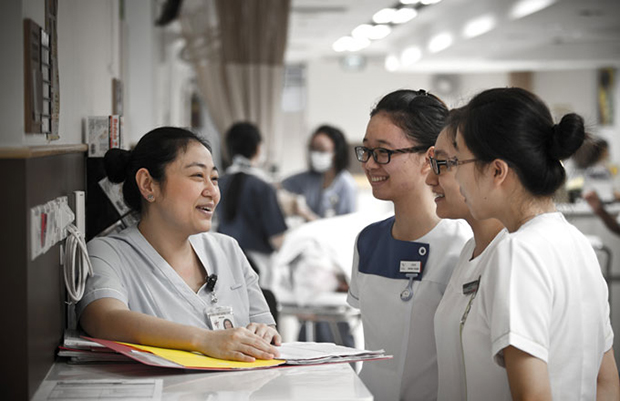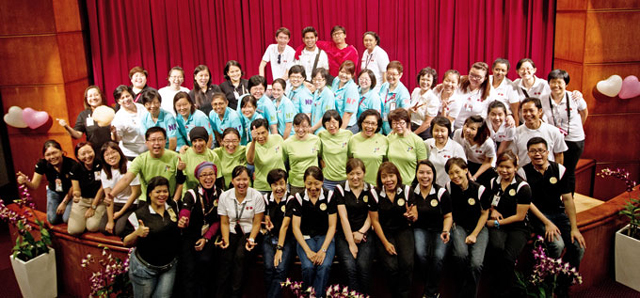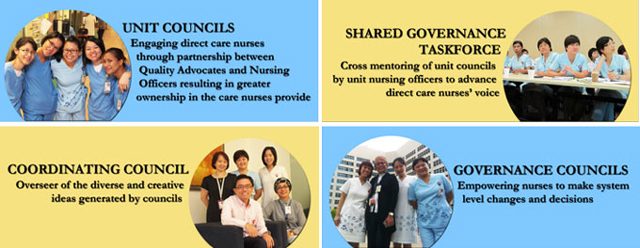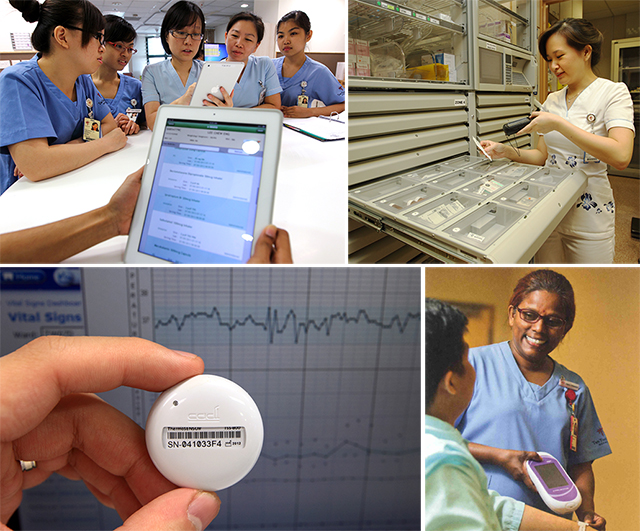Nursing Career and Specialisation
As a nurse at TTSH, your career can take many paths.
Based on your strengths and aspirations, you can explore different tracks in education, research or management. Or pursue the clinical track to become a Nurse Clinician or Advanced Practice Nurse.
 Advanced Practice Nurse Geraldine Ng (General Medicine) conducts an informal discussion with nursing students.
Advanced Practice Nurse Geraldine Ng (General Medicine) conducts an informal discussion with nursing students.
Regardless of the path you choose, numerous opportunities for skills and knowledge upgrading are abound – for example, post-NITEC courses, basic or advanced Diploma, Bachelor’s degree, Masters or PhD in nursing or other related fields. This additional training will enable you to assume advanced clinical and leadership roles, within different settings, to impact both patient care and the healthcare industry.
Shared Governance Model
 Members of the four Governance Councils and the Pathway Committee gather together for their first Pathway Fiesta in May 2013.
Members of the four Governance Councils and the Pathway Committee gather together for their first Pathway Fiesta in May 2013.
Under the Pathway to Excellence programme, TTSH Nursing began a transformational journey to flatten the nursing dynamics from a traditional hierarchical model of interaction to a culture of empowerment. A Shared Governance Model was introduced to support nurses in defining their practices and improving quality and patient satisfaction, through a collaborative decision making process. Thus, the whole paradigm of management-led decision-making was redesigned to include ideas and views from all levels of nurses.

A Great Place to Work
Flexible Rostering
With the introduction of flexible-rostering, nurses can now request for half-day leave or mutual exchange of shift among staff with similar skill mix. It facilities better integration of work, personal time and family responsibilities.
Buddy system
The demands of coping with a new job in today’s acute and highly complex environment can be daunting for our new nurses, more so for our foreign nurses. Although the existing preceptorship scheme had been in place, our buddy system offers an informal and friendly support to help them assimilate and integrate better in TTSH.
Healthy Campaigns
We aim to promote health and wellness within the nursing workforce. A couple of key events we organised over the past year were the health screening and flu vaccinations, our collaboration with Allied Health Department to elevate the well-being of our nurses through Traditional Chinese Medicine, Podiatrist and Dietitian services, and even free yoga sessions.
Clinical Exchange Program
Clinical exchange program allows staff to experience other nursing areas through attachment, cross training or internal transfer. The nurse can have better insight on the different work cultures and environments, and a platform to enrich clinical knowledge and skills. The program could also help nurses to identify potential interest or specialty areas for further career development.
Nursing Innovation

A thriving innovation ecosystem requires the nurturing of a supportive culture that invites diverse perspectives, encourages a spirit of experimentation, and reassures to promote a positive culture where “failures” are considered learning opportunities.
As part of the Shared Governance’s innovation ecosystem, the newly minted Nursing Innovation Governance Council (NIGC) and TTSH’s Nursing Innovation Bunch (NIB) play a pivotal role in anchoring innovation uptake in the TTSH nursing community. These enabler units provide strategic support, resources, and collaborative platforms to actively engage our nurses throughout their innovation journey.
Let Future Nurses be engaged and empowered to define the Future of Nursing as the profession extends its capabilities to achieve better health outcomes for our population, create value and contribute to health care sustainability for the future.
Read more
Seed funding for multiple projects have been financially supported by the Nursing Innovation Fund (NIF) and NIGC Fund for nurse innovators to develop working prototypes, with the aim of solving problems in their daily work, transforming the way in which they deliver care. To date, more than 100 innovation ideas and prototypes have been supported, along with facilitation and mentorship from NIGC and NIB.
To enculturate future nurses early into TTSH’s innovation ecosystem of shared values and attitudes, every new nurse or *prospective new nurse (i.e. nursing students) are encouraged to apply for a $1,000 innovation seed fund to create the change they wish to see for better care and a better workplace. The nurses will find support and guidance from their managers and TTSH NIB to clarify the gaps, develop prototypes, perform iterative testing and learning, and finally implementing their ideas and scaling it up to the frontline or support units.
*From eligible Institutes for Higher Learning such as: Institute of Technical Education (ITE), Ngee Ann Polytechnic (NP), Nanyang Polytechnic (NYP), National University of Singapore (NUS), or Singapore Institute of Technology (SIT).
You may apply for NIF or NIGC Fund via our application form.
Nursing Innovation Fund
Nursing Technology

"We nurse our patients with cutting-edge technology to save time and effort as well as cutting done errors."
Radio Frequency Identification (RFID) technology and SmartSense Vital Sign Monitoring System
What it is: A system using Radio Frequency Identification (RFID) technology to track a patient’s location as well as body temperature.
- Location tracking – RFID facilitates patient location tracking at the inpatient wards and reduced time taken to locate patients out of the wards. It promotes better coordination of patient flow, better manages utilization of limited resources and provides real-time status of ward capacity to the Emergency Department (ED), Bed Management Unit (BMU) and wards.
- Temperature monitoring – The RFID constantly monitors patient’s body temperature and wirelessly upload the readings to electronic clinical chart. It also keeps a permanent electronic record of vital signs like blood pressure, pulse and respiration, which are entered manually to the system.
Closed Loop Medication Management System (CLMMS)
What it is: An electronic system for the processes of medication prescribing, reviewing, dispensing and administration to ensure that the correct medication is served to the right patient at the right time. It consists of three components:
- Electronic Inpatient Medication Record and Inpatient Medication Administration Record (eMAR-iMAR) – e-records for medication prescription, medication review and administration purposes.
- Electronic Medication Administration Record System (EMARS) – Medication administration system used by nurses to administer medications. Paired with a PDA (in process of switching to mini iPads) to scan the barcodes of medication and patient’s identification on the wrist band, it ensures that the right patient is given the right drug at the right time, and even indicates any allergies or contraindicative medication.
- Omnicell Automated Dispensing Cabinet (ADC) – A secured system for efficiently managing, storing, dispensing medications. The guiding lights guide the user to the desired location in the cabinet to remove the correct medications. Other safety features include bin-locked compartments and controlled access such as thumbprint verification. The system also facilitates medication inventory process and triggers resupply of medications to the specific Omnicell cabinet.
Intellivue Clinical Information Portfolio (ICIP)
What it is: A comprehensive patient-data management system, which complies their parameters, assessment and notes from doctors, nurses and Allied Health Service (AHS) staff in one place for easy referring and sharing. This system is used in intensive care units.